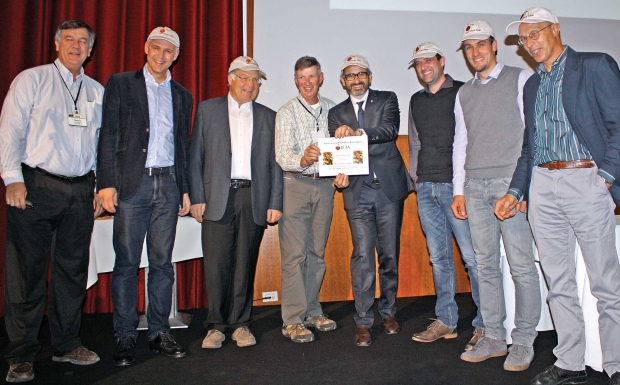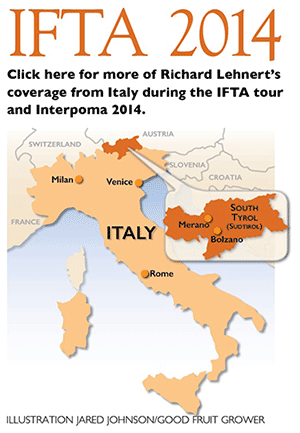
Apple growers traveling with IFTA in November, 2014 learned how to grow apples, South Tyrolean style, from a group of experts. From left are Terence Robinson, Cornell University; Markus Bratlwarter, SK Sudtirol, evaluator of new varieties; Kurt Werth, consultant and tour organizer; Phil Schwallier, Michigan tree fruit educator and president of IFTA; Michael Oberhuber, research station at Laimburg; Jurgen Christanell, South Tyrol extension service expert on orchard design; Robert Wiedmer, extension; and Walter Rass, extension expert on mechanization. (Richard Lehnert/Good Fruit Grower)
In northern Italy, in the autonomous province of South Tyrol, about 6,000 small farms cultivate 45,000 acres of land devoted to apple production, the largest concentration of apples in Europe. The region supplies half of the Italian market and 15 percent of the European market.
Since the end of World War II, stakeholders in that apple industry have organized themselves in what Bolzano apple consultant Kurt Werth—and European sociologists—call a LINSA, a Learning and Innovation Network for Sustainable Agriculture.
The most important drivers are apple producers’ cooperative system and their strict adhesion to the basic principles of self-help, self-administration, self-responsibility, and member promotion.
“The apple producers in South Tyrol have created a LINSA guided by human relationships, trust, common vision, and interest where information and knowledge are transferred easily and underpinned by rapid and collective action for innovation,” Werth wrote.
If this all sounds academic, it comes from a paper he co-authored in 2014 for the Food and Agriculture Organization of the United Nations. It was a case study in agricultural innovation, something that might serve as a model for farmers elsewhere in the world.
 This network around the apple in South Tyrol has parallels to the land-grant university system in the United States, but in Tyrol much of it is grower-owned and grower-controlled. While the European equipment and chemical companies are private, they must key in on the desires of the growers and their powerful advisors to prosper.
This network around the apple in South Tyrol has parallels to the land-grant university system in the United States, but in Tyrol much of it is grower-owned and grower-controlled. While the European equipment and chemical companies are private, they must key in on the desires of the growers and their powerful advisors to prosper.
Here are some elements in the network:
The producer cooperatives
There are many of them, at least 43. They are themselves cooperators in two large marketing cooperatives, VI.P and VOG, which pack and sell 98 percent of the Tyrol’s apples.
The cooperatives represent the growers, and the growers, using their co-ops, come to agreement on just about everything—the varieties of apples they will raise; the varieties of trees they will grow and rootstocks they will plant them on; how they will manage frost and hail hazards; and how they will share machinery to lower production costs.
Extension of knowledge
The growers support an independent advisory group similar to the Cooperative Extension Service in the United States. The title, in English, is the South Tyrolean Extension Service for Fruit and Wine Growing. Its website is beratungsring.org.
Robert Wiedmer, the director, said it was founded in 1957. “Growers wanted an independent, objective source of information that was both up-to-date and neutral,” he said.
The nonprofit organization is directed by a board of 12 growers, elected every four years, representing seven districts, and doing business in both Italian and German.
Among the services it provides growers are interpretation of soil and foliar analysis and fertilizer recommendations, aid with sprayer calibration, planning for new orchards, and about 100 local seminars, conferences, and workshops each year. It provides printed field guides, email warnings on apple scab, and web-based information on pesticides, irrigation management, fire blight infection risks, and weather.
Growers pay fees of about 200 euros per hectare of orchard (about $100 an acre) and the government of South Tyrol (which is semi-autonomous in the Italian federation) adds to it, paying about a quarter of the total cost.
Variety innovation
In 2002, a varietal innovation consortium called SK South Tyrol was formed to study new varieties—and develop some as well—to make sure South Tyrol growers have access to new and potentially exclusive varieties.
In a time frame of about 10 years, candidate apple varieties are put through their paces to test their suitability for growing, storing, and marketing by the growers of South Tyrol. A dossier is built, a final assessment is made, and a decision rendered: Should it be introduced or rejected.
The consortium is funded by the marketing co-ops, two-thirds by VOG, one-third by VI.P, who have a large say in the decision to grow or not to grow, because they will store, pack, and sell the fruit. On average, the South Tyrolean industry introduces a new variety about once every six years, Bradlwarter said.
Nursery stock
A consortium of nurseries, called KSB, turns out certified high-quality trees. The South Tyrol growers gobble up the best trees, those with seven or more feathers. One of the large nurseries, GRIBA, has introduced a quality grading system that sorts trees into several grades based on caliper and number and size of feathers.
Apple research
While some basic research and formal education takes place at the Free University of Bozen-Bolzano, the key player in South Tyrol is the Agricultural Research and Innovation Network, centered at the research station at Laimburg. There, research is oriented to solving and preventing problems in the field and post-harvest. It is directed by Michael Oberhuber and involves some 200 people on the research team.
Founded in 1975, it is part of the local government of South Tyrol, much as the land-grant-university-based system is in the United States. The researchers, Oberhuber said, work in areas of soil fertility and irrigation, pomology, variety testing (and breeding, since 1997), plant physiology (planting, training, and pruning), storage, plant protection through research on the biology of pests and beneficials, and pesticide testing. It is all directed at solving the problems of mountain agriculture.
“It is easier to make more money than to save on costs,” Oberhuber said. The research is aimed at driving up yields and quality so growers can derive more income per hectare. •






Leave A Comment